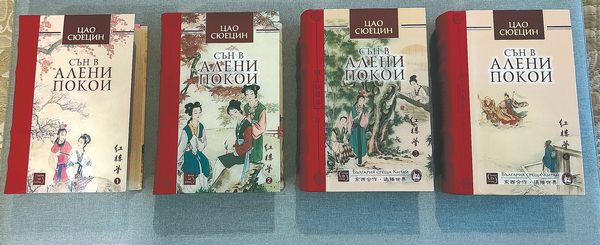

Art of interpretation
Despite the several classic works in ancient Chinese that he had translated, A Dream of Red Mansions was always on his mind. He identified with the male protagonist, Jia Baoyu.
"Jia does things from the heart, sometimes behaving childishly. He's so incompatible with his society that others view him like an eccentric, but I would say he was just born in the wrong time," Hinov once said.
Although Jia, the family favorite, has many expectations upon him, he has no interest in pursuing success, but likes to stay with his sisters, female cousins and cousins-in-law, viewing girls as pure and beautiful. He's considerate with the housemaids, too.
The characters enjoy an abundant, literary and, to some extent, utopian life in the early years, creating a large amount of highly diverse poems.
Therefore, Hinov personally would recognize the author, Cao, as a poet rather than a novelist.
"The art of translation is like crossing a river running between the banks of two different civilizations. When choosing which stones to tread on, the translator is actually defining his own style and methodology," Hinov once said.
A Dream of Red Mansions contains numerous descriptions of costumes, utensils, jewelry, folk conventions, traditional Chinese medicine and architecture.
Its language styles range from formal expressions between officials and aristocrats, to different dialects, slang and profanity, and switch between ancient written prose and vernacular Chinese.
Names of the people often contain homophonic puns, and there are many metaphors concealed between the lines.
No wonder it's the only single piece of Chinese work that has developed a separate school of research, and it's not hard to imagine the workload of its translation. Just for the first volume, Hinov had prepared over 400 annotations, explaining Chinese cultural concepts and historical allusions.
He also resorted to ancient Bulgarian poetry and prose and Slavic words to keep the beauty of Cao's original work.
To help readers understand, he included 60 illustrations from the 1791 and 1792 versions and also a family tree of the main characters, according to Nora Chileva, author of an essay reviewing Hinov's translation.
Hinov once said: "The translator must go through a period when he gradually grasps the style, techniques and way of thinking of the author, and learns to integrate them into his own language."
His taste for literature was rooted in fairy tales read during childhood, usually written in an outdated Bulgarian style that's rarely used in modern society. Therefore, he was more comfortable with ancient works and felt closer to the thinking of ancient people.
"It's rare to see Chinese literary works of cultural importance in my country. For me, to publicize Chinese culture here, I would like to start with books like A Dream of Red Mansions, The Four Books and The Book of Songs that laid the foundation of the culture, otherwise it's not reasonable enough to translate modern works," he said, adding that, in his view, modern literature, more or less influenced by globalization and the internet, is not really able to represent Chinese cultural connotations.